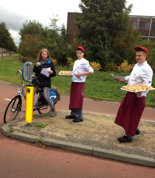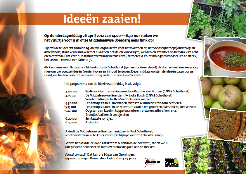‘Week van de Smaak’ Education for 13-20 years old
May 28, 2013
Contributor: Anne de Feijter, Amersfoort
Workshop: Governance, synergies and local systems / Final consumers – Youngsters
During ‘Week van de Smaak’ (= Week of the Taste) many students from vocational and secondary schools in Amersfoort get acquainted with regional food.


During ‘Week van de Smaak’ (= Week of the Taste) many students from vocational and secondary schools in Amersfoort get acquainted with regional food. In September 2012 many different projects were organized by local parties:
- Students prepared regional snacks and distributed them to people in the street.
- Students from the cooking school worked in an allotment garden to see how vegetables grow. They harvested ‘forgotten vegies’ as parsnip and turnip and back at school prepared meals with them.
- Students cooked a regional menu for local residents who live nearby the school.
- A ‘potato taste event’ for the general public was organized by a group of students at a local restaurant. See: http://www.youtube.com/watch?v=iPfJQ9g4CIk
- Students prepared healthy sandwiches during their ‘Human & Nature’ lessons and sold them during the school break to other students and teachers.
Week van de Smaak is a nationwide, yearly project in which Amersfoort participates. See: http://www.weekvandesmaak.nl/.
These projects are the results of a first meeting in the spring of 2012, in which the network approach was leading. The meeting was organized by the CNME, part of the Environmental Department of the Municipality of Amersfoort. During this meeting, titled: ‘To plant ideas!’, many different parties were invited. (See above for the invitation this meeting.) Goal was to have an open brainstorm on which educational projects could be done during the Week van de Smaak. The meeting was held around an open fire at an allotment garden. At the end of the meeting parties worked together in the garden and joined a meal of bread and soup. Many parties ‘found each other’ during this meeting and made plans to develop projects together (without further effort – time or money – of the CNME).
Goals:
- To make students aware of healthy food patterns.
- To make students aware of the origin of their food. What does it take to grow vegetables?
- To make students aware of the sustainable aspects of food (growing, transporting and preparing).
- To make students aware of the choices they have in their daily lives concerning food.
Experiencing local food (seeing how products are being grown, harvesting them yourself and later on preparing a meal with those products), help youngsters understand the origin of their food. This has proved to be a perfect base to discuss other food issues as: sustainable aspects of food, organic food, local/regional products, the daily choices concerning food one has.
Besides the result described above, the spin-off of facilitating the initial meeting has proved to be large. In these many different projects both secondary and vocational schools participate. Also, many restaurants and growers of regional food participate. Many of these parties never knew each other before. So, these synergies contribute to the development of a local network of parties involved in urban agriculture.
The local press was enthusiastic; many articles and short films were published. It puts the subject of urban agriculture on the map.
Pro:
- Quick results after first ‘meet and match’ meeting, with little contribution (time and money) from the municipality.
- Many students have experienced local food in some or another way.
- The press likes attractive, onetime food events with youngsters.
- Also aldermen and other politicians like to open or be present at events in which many local parties participate.
Contra:
- These projects all had a temporary, one time character. It is hard to define or monitor whether participating in these kind of onetime events actually contributes to a behavioural change and effectively lessen footprints of youngsters.
The network approach (bottom-up approach) is very interesting to experiment with. In society many active parties are present. Bring them together and synergies seem to arise automatically.
See for more information on this theory: http://www.toolsfornetworkers.nl/. This is a site in English!
How can we move from onetime, successful projects to constructive, structural education on the subject of (local) food?